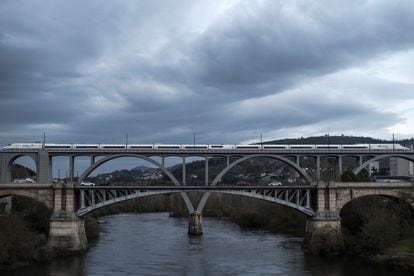King Felipe VI, at the inauguration of the Madrid-Ourense line, in November 2021.FRANCISCO GOMEZ / SPANISH ROYAL (EFE)
If someone wanted to distinguish Spain by a singular rank that would differentiate it from the rest of the almost 200 nations recognized by the UN, they could not do so because of its language or its religion (common to many other countries), nor because of its history (in permanent revision ) and not even for its gastronomy (after the globalization of paella). But it could well define it as the state with the world's greatest devotion to high-speed rail. After the inauguration of the section of the Madrid-Galicia line to Ourense last November, the Spanish high-speed network has reached 3,700 kilometers, only surpassed in extension by the Chinese, although not even the Asian country resists the comparison if it is it takes into account the geographic extent and population of both countries.
Furthermore, the AVE is almost the only unison claim in which the various political forces coincide. All the autonomies, regardless of the formation that the Government occupies, demand that the AVE arrive as soon as possible to their territories. Even EH Bildu, although reluctant with spending and the utility of the network, no longer dares to directly request a boycott of the arrival of the AVE to the Basque Country, which in the past motivated a campaign of sabotage (murders included) of the band ETA terrorist. The extreme defense of the fast train as the axis of the Spanish railway model has come to face reports from institutions such as the European Union, Airef or the Court of Accounts, which consider that the economic effort is not compensated by the use of these infrastructures,and that these funds could be used to improve the conventional network with better Cercanías and Regional connections, on which the daily mobility of citizens depends much more.
The current Government of Pedro Sánchez, like the previous ones, continues to advance in that state ambition to take the AVE to at least each provincial capital. There are currently three corridors completed –the ones that link Madrid with the French border, Andalusia and Levante-, with 14 high-speed lines in service: Madrid-Seville; Madrid-Toledo; Madrid-French border; Zaragoza-Huesca; Madrid-Valladolid; Cordoba-Malaga; Madrid-Palencia-León; Madrid-Ourense; Vigo-A Coruña; Ourense-Santiago; Madrid-Valencia / Alicante; Seville-Cádiz; Antequera-Granada, Variante de Vandellós and Monforte del Cid-Orihuela / Beniel. And the Mediterranean and Extremadura corridors, the Basque Y, the completion of the connection to Galicia, Asturias and Santander are under construction.
Although several heads of the Central and regional administrations periodically make statements about the extension of the high-speed map, the time frame is very wide: it is estimated that it will be completed between the end of 2026 and 2030. And it is that the deadlines for the completion of All these projects are not very precise, in large part because the current Executive does not want to get his hands caught with promises, taking into account the bad precedents. And it is that all the governments of PSOE and PP have failed in an almost generalized way the successive forecasts that they made since in 1989 the works of the Madrid-Seville line began, with which the high speed line was inaugurated in Spain, although the first The train did not run until 1992, on the occasion of the Universal Exposition of Seville.
By 2022, the State, through Adif, plans to invest 2,591 million euros in the extension of the high-speed network. As the main milestone, and according to sources from the Ministry of Transport, Mobility and Urban Agenda (Mitma), over the next year the following sections of four high-speed lines will be put into service, although always awaiting the mandatory tests: the connection Venta de Baños (Palencia) -Burgos, 89 kilometers long; the Beniel-Murcia El Carmen station section (north vessel) of the Monforte del Cid-Murcia line; phase 1 of the Plasencia-Cáceres-Badajoz section of the line to Extremadura (164.6 kilometers); and the standard gauge tunnel between Madrid's Chamartín and Puerta de Atocha stations (7.3 kilometers). In the case of this infrastructure,its implementation will not only allow connecting these two stations in the capital, but also all the high-speed corridors.
As for the rest of the runners, this is the situation and their completion plans:
Mediterranean corridor
.
The official estimate is that by the end of 2025 or by the beginning of 2026 the construction works of the entire corridor from Almería to the French border will be completed.
At present, work is being carried out on the different sections that are in different degrees of execution.
Among the works in progress, the recent award of contracts to implement the standard gauge, the high speed one, between Castellón and Vandellós, in what constitutes the first change of gauge of a conventional line stands out.
The works for the construction of the route between Murcia and Almería have also just started.
Extremadura corridor.
Its about
The most overdue project since it has suffered more than twenty delays since it was planned and there is even a citizen platform demanding a worthy railway connection for the region, which has the oldest network in Spain (the last wooden sleepers were withdrawn this year ), and it's not even electrified. President Pedro Sánchez has recently promised that the Plasencia-Badajoz section will be operational in the summer of 2022. The second section that runs between Plasencia and the border between the province of Cáceres and that of Toledo (Talayuela, on the one hand, and Oropesa, on the other hand, other) is in different phases of execution, including electrification, although it will not be operational until at least 2025. Regarding the third section, the Madrid-Oropesa, it is in the informational study phase, and the most optimistic forecasts speak of 2028 as the date of premiere,Although the most realistic ones extend the term at least until 2030. When it is a reality, traveling from Madrid to Badajoz will go from lasting from the current five and a half hours to less than two hours.
Connection to Santander.
There is no date to extend the AVE from Palencia to Santander.
The previous Minister of Transport, José Luis Ábalos, spoke that in 2024 it would be a reality, but the current cabinet led by Raquel Sánchez has not endorsed that forecast.
The president of Cantabria, Miguel Ángel Revilla, has celebrated as a milestone the start of the works during the year that has just ended on the sections of the Palencia-Amusco and Amusco-Osorno, while the projects are currently being drawn up to build another three (Palencia- North Palencia, Osorno-Calahorra de Boedo and Calahorra de Boedo-Alar del Rey).
The inaugural train of the AVE qa Galicia crosses a bridge in Ourense, on November 20 Brais Lorenzo (EFE)
The Basque 'Y'
. The high-speed train that will circulate in the Basque Country, known as the Basque 'Y' due to the shape of the 175-kilometer route that connects the three Basque capitals, was planned in 1989 and works did not begin until October 2006. Execution of the works accumulates many delays and the project will not be completed, according to the latest forecasts made this year by the Basque Minister of Transport, Iñaki Arriola, until the end of 2026 or the beginning of 2027. Many more unknowns, due to nationalist reluctance, weigh on the connection of the Basque 'Y' with the rest of the Spanish high-speed network from Vitoria to Burgos.
Connection to Asturias.
The arrival of the AVE to Asturias involves solving the connection through a double tunnel between León and Asturias (Pajares variant), whose works and subsequent tests of the infrastructure are expected to be ready by the end of 2022, although it is foreseeable that it will be completed. Go into the early part of 2023.
Corridor to Galicia.
After the inauguration on December 20 of the Madrid-Ourense route, the extension of the network to A Coruña and Santiago de Compostela has no official date.
The respective mayors speak of the end of 2022, but in addition to the road, the stations must be adapted, so it will be difficult to travel to these two Galician capitals until well into 2023.
Other actions. In addition to the large corridors, work is underway to shortly put out to tender the works of other outstanding projects, including the standard gauge connection to the Madrid-Barajas airport from the Chamartín station and the connection between the Madrid-Levante high-speed lines and Madrid-Barcelona. In this case, this
bypass
has recently been put out to tender,
which will allow the trains of the Barcelona line to be routed to the new passing platforms that will be built at the Atocha station, and from there and through the aforementioned new tunnel, they can continue to the station. from Chamartín and connect with the northern half of the country.
Last Thursday, the Chamartín station expansion works were awarded, works prior to its next comprehensive remodeling.
Likewise, it is expected that in 2022 the second phase of the expansion of the Atocha station will be put out to tender, while construction work on the Barcelona La Sagrera station continues.









